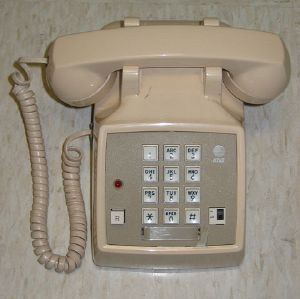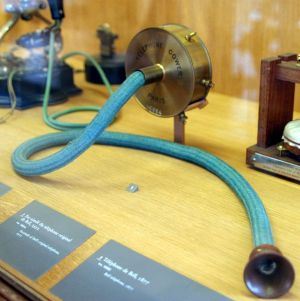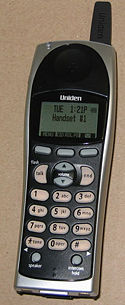Telephone
The telephone (Greek: tele = far away; phone = voice) is a telecommunications device that is used to transmit and receive sounds (most commonly voice and speech) across distances. Most telephones operate through the transmission of electric signals over a complex telephone network that allows almost any phone user to communicate with almost any other.
Introduction
An elementary telephone system consists of three basic elements:
- each subscriber's equipment, which converts sound to electrical signals and vice versa, and which allows the subscriber to initiate or answer a call;
- a central switching facility that interconnects the subscribers;
- wiring or other equipment that connects the subscribers to the central switching facility.
A subscriber may be connected to the telephone network in one of three principal ways:
- Historically, and still very commonly, by dedicated physical wire connections run in overhead or underground cables.
- By radio, as in a cordless, cellular, satellite, or radio telephone.
- By voice over Internet protocol (VoIP) telephones, which use broadband Internet connections.
Between end users, transmissions across a network may be carried by fiber optic cable, landline cable, point-to-point microwave or satellite relay.
Until relatively recently, a "telephone" generally referred only to landlines. Cordless and mobile phones are now common in many places around the world, with mobile phones expected to gradually displace the conventional landline telephone. Unlike a mobile phone, a cordless phone is considered landline because it is usable only within a short distance of a personal or domestic base station connected to a fixed phone line.
History
The identity of the inventor of the electric telephone remains in dispute. Antonio Meucci, Johann Philipp Reis, and Alexander Graham Bell, among others, have all been credited with the invention. Moreover, the early history of the telephone is a confusing morass of claims and counterclaims, which was not clarified by the huge mass of lawsuits that hoped to resolve the patent claims of individuals. Much money was expended, particularly in the Bell Telephone companies, and the aggressive defense of the Bell patents resulted in much confusion. Additionally, the earliest investigators preferred publication in the popular press and demonstration to investors instead of scientific publication and demonstration to fellow scientists.
It is important to note that there is probably no single "inventor of the telephone." The modern telephone is the result of the work of many, all worthy of recognition of their contribution to the field. Recently, however, the British government announced that it now recognizes (primarily for educational purposes) Antonio Meucci (see below) as the 'first inventor' of the telephone.
A timeline of the invention and development of the telephone is given below.
77777777777777
Early development
The following is a brief summary of the history of the invention of the telephone:
- 1849 Antonio Meucci, an Italian living in Havana, demonstrates a device he later called a telephone. (The demonstration involves direct electrical connections to people.)
- 1854 Charles Bourseul publishes a description of a make-break telephone transmitter and receiver but does not construct a working instrument.
- 1854 Meucci demonstrates an electric telephone in New York. [1]
- 1860 Johann Philipp Reis demonstrates a "telephon" using a pressure contact transmitter after the make-break design of Bourseul and a knitting needle receiver. Witnesses said they heard human voices being transmitted.
- 1860 Meucci demonstrates his telephone on Staten Island.
- 1861 Reis manages to transfer voice electrically over a distance of 340 feet, see Reis' telephone.
- 1864 In an attempt to give his musical automaton a voice, Innocenzo Manzetti invents the 'Speaking telegraph'. He shows no interest in patenting his device, but it is reported in newspapers.
- 1865 Meucci reads of Manzetti's invention and writes to the editors of two newspapers claiming priority and quoting his first experiment in 1849. He writes "I do not wish to deny Mr. Manzetti his invention, I only wish to observe that two thoughts could be found to contain the same discovery, and that by uniting the two ideas one can more easily reach the certainty about a thing this important." If he reads Meucci's offer of collaboration, Manzetti does not respond.
- 1871 Meucci files a patent caveat (a statement of intention to patent).
- 1872 Elisha Gray founds Western Electric Manufacturing Company.
- 1872 Prof Vanderwyde demonstrated Reis's telephone in New York.
- July 1873 Thomas Edison notes variable resistance in carbon grains due to pressure and builds a rheostat based on the principle.
- May 1874 Gray invents electromagnet device for transmitting musical tones. Some of his receivers use steel diaphragms.
- December 1874 Gray demonstrates his musical tones device at the Presbyterian Church in Highland Park, Illinois and lectures on the possibility of transmitting speech.
- 2 June 1875 Alexander Graham Bell transmits the sound of plucked steel reeds using electromagnet instruments.
- 1 July 1875 Bell uses a bi-directional "gallows" telephone that was able to transmit "indistinct but voicelike sounds" but not clear speech. Both the transmitter and the receiver were identical membrane electromagnet instruments.
- 1875 Thomas Edison experiments with acoustic telegraphy and in November builds an electro-dynamic receiver but does not exploit it.
- 11 February 1876 Elisha Gray invents a liquid transmitter for use with a telephone, but does not build one.
- 14 February 1876 (about 9:30 am) Gray or his lawyer brings to the Patent Office Gray's caveat for the telephone. (A caveat was a notice of intention to file a patent application)
- 14 February 1876 (about 11:30am) Bell's lawyer brings to the Patent Office Bell's patent application for the telephone. Bell's lawyer requested that it be registered immediately in the cash receipts blotter.
- About two hours later Elisha Gray's caveat was registered in the cash blotter. Although Gray could have converted his caveat into a patent application, he did not do so.
- 7 March 1876 Bell's US patent 174,465 for the telephone is granted.
- 10 March 1876 Bell transmits speech "Mr. Watson, come here, I want you." using a liquid transmitter and an electromagnetic receiver.
- 16 May 1876 Thomas Edison files first patent application for acoustic telegraphy.
- 20 January 1877 Edison "first succeeded in transmitting over wires many articulated sentences" using carbon granules as a pressure sensitive variable resistance under the pressure of a diaphragm (Josephson, p143).
- 30 January 1877 Bell's US patent 186,787 is granted for an electro-magnetic telephone with transmitter and receiver using steel diaphrams and a call bell.
- 4 March 1877 Emile Berliner invents a microphone based on the "loose contact" between two metal electrodes, an improvement on the Reis telephone, and in April 1877 files a caveat of an invention in process.
- 27 April 1877 Edison files for a patent on a carbon transmitter which included the first use of a induction coil or transformer with the transmitter and battery in the primary circuit. The patent was granted after a 15 year delay due to litigation. In 1892 a federal court ruled Edison and not Berliner was the inventor of the carbon transmitter. Edison's carbon transmitter and Bell's electromagnetic receiver were used by the Bell system for many decades thereafter (Josephson, p 146).
77777777777
Later history
The history of additional inventions and improvements of the electrical telephone includes the carbon microphone (later replaced by the electret microphone now used in almost all telephone transmitters), the manual switchboard, the rotary dial, the automatic telephone exchange, the computerized telephone switch, Touch Tone® dialing (DTMF), and the digitization of sound using different coding techniques including pulse code modulation or PCM (which is also used for .WAV, .AIF files and compact discs).
Newer systems include IP telephony, ISDN, DSL, mobile cellular phone systems, cordless telephones, and the third generation cell phone systems that promise to include high-speed packet data transfer.
The industry has divided into telephone equipment manufacturers and telephone network operators (telcos). Operating companies often hold a national monopoly. In the United States, the Bell System was vertically integrated. It fully or partially owned the telephone companies that provided service to about 80% of the telephones in the country and also owned Western Electric, which manufactured or purchased virtually all the equipment and supplies used by the local telephone companies. The Bell System divested itself of the local telephone companies in 1984 in order to settle an antitrust suit brought against it by the United States Department of Justice.
In 1926 Bell Labs and the British Post Office engineered the first two-way conversation across the Atlantic.
The first commercial transatlantic telephone call was between New York City and London and occurred on January 7, 1927.
Digital Telephony
The Public Switched Telephone Network (PSTN) has gradually evolved towards digital telephony which has improved the capacity and quality of the network. End-to-end analog telephone networks were first modified in the 1970s by upgrading long-haul transmission networks with SONET technology and fiber optic transmission methods. Digital transmission made it possible to carry multiple digitized switched circuits on a single transmission medium (known as multiplexing). While today the end instrument remains analog, the analog signals reaching the aggregation point (Serving Area Interface (SAI) or the central office (CO) ) are typically converted to digital signals. Digital loop carriers (DLC) are often used, placing the digital network ever closer to the customer premises, relegating the analog local loop to legacy status.
Wireless phone systems
While the term "wireless" means radio and can refer to any telephone that uses radio waves, it is primarily used for cell phones. In the United States wireless companies tend to use the term wireless to refer to a wide range of services while the cell phone itself is called a mobile phone, mobile, PCS phone, cell phone or simply cell with the trend now moving towards mobile.
The changes in terminology is partially due to providers using different terms in marketing to differentiate newer digital services from older analog systems and services of one company from another.
Cordless telephone
Cordless telephones, invented by Teri Pall in 1965, consist of a base unit that connects to the land-line system and also communicates with remote handsets by low power radio. This permits use of the handset from any location within range of the base. Because of the power required to transmit to the handset, the base station is powered with an electronic power supply. Thus, cordless phones typically do not function during power outages. Initially, cordless phones used the 1.7 MHz frequency range to communicate between base and handset. Because of quality and range problems, these units were soon superseded by systems that used frequency modulation (FM) at higher frequency ranges (49 MHz, 900 MHz, 2.4 GHz, and 5.8 GHz). The 2.4 GHz cordless phones can interfere with certain wireless LAN protocols (802.11b/g) due to the usage of the same frequencies. On the 2.4 GHz band, several "channels" are utilized in an attempt to guard against degradation in the quality of the voice signal due to crowding. The range of modern cordless phones is normally on the order of a few hundred meters.
Mobile phones
Most modern mobile phone systems are cell-structured. Radio is used to communicate between a handset and nearby cell sites.
When a handset gets too far from a cell site, a computer system commands the handset and a closer cell site to take up the communications on a different channel without interrupting the call.
Radio frequencies are a limited, shared resource. The higher frequencies used by cell phones have advantages over short distances. Connection distance is somewhat predictable and can be controlled by adjusting the power level. By only using enough power to connect to the "nearest" cell site phones using one cell site will cause almost no interference with phones using the same frequencies on another cell site. The higher frequencies also work well with various forms of multiplexing which allows more than one phone to connect to the same tower with the same set of frequencies.
Satellite phones
Some mobile telephones, especially those used in remote locations, where constructing a cell network would be too unprofitable or difficult, instead communicate directly with an orbiting satellite. Such devices tend to be bulkier than cell-based mobile phones, as they require a large antenna or dish for communicating with the satellite, but do not require ground based transmitters, making them useful for communicating from remote areas and disaster zones.
Semi-Cordless Phone
There are phones that work as a cordless phone when near their corresponding base station (and sometimes other base stations) and work as a wireless phone when in other locations but for a variety of reasons did not become popular.
Some kinds of cordless phones work like cellular phones but only within a small private network covering a building or group of buildings. These kinds of systems using VoIP are popular in hospitals and factories where the same wireless network can be used for both data and voice.
VoIP Telephony
Also known as Internet telephony or Voice over IP (VoIP), digital telephony is a disruptive technology that is rapidly replacing traditional telephone networks. In Japan and Korea up to 10% of subscribers, as of January 2005, have switched from analog to digital telephone service. A recent Newsweek article suggested that Internet telephony may be "the next big thing." [2]
There are many VoIP providers on the market (such as Packet8, Vonage, and Sunrocket) at the moment, and statistics suggest over 40% of the world population will have switched to VoIP by year 2010.[citation needed]
Digital telephones use a broadband Internet connection to transmit conversations as data packets. In addition to replacing the PSTN, digital telephony is also competing with mobile phone networks by offering free or lower cost connections via WiFi hotspots. As mentioned above VoIP is also used on private wireless networks which may or may not have a connection to the outside telephone network.
Telephone equipment research labs
Bell Labs is a noted telephone equipment research laboratory, amongst its other research fields..
Telephone operating companies
In some countries, many telephone operating companies (commonly abbreviated to telco in American English) are in competition to provide telephone services. Some of them include those in the following list. However, the list only includes providers of copper wires from the exchange to the user, not those who only supply "Voice over IP" or only transport voice signals between exchanges. See also: List of telephone operating companies
Trivia
- The modern handset came into existence when a Swedish lineman tied a microphone and earphone to a stick so he could keep a hand free.
- The folding portable phone was an intentional copy of the fictional futuristic communicators (which in use actually more closely resembled walkie-talkies, Nextel-style) used in the television show Star Trek.
- In Unicode, telephones are depicted with the characters whose hexadecimal codes are 260E (☎), 260F (☏) and 2706 (✆), (but may not display properly in some browsers).
See also
Telephone equipment |
Telephone equipment manufacturersSeveral manufacturers build telephones of all kinds. Some of these are:
|
Telephone technology
|
Telephone system, organization, and structure
|
Telephone hacking and exploitation
|
Telephony in the USA
Telephony outside the USA
|
Telephone terminology
|
Telephone StandardsWired Standards
Wireless StandardsThere are many standards for common carrier wireless telephony, often with incompatible standards used in the same nation:
Other
|
Patents
- US 174,465 — Telegraphy (Bell's first telephone patent) — Alexander Graham Bell
- US 3,449,750 — Duplex Radio Communication and Signalling Appartus — G. H. Sweigert
- US 3,663,762 — Cellular Mobile Communication System — Amos Edward Joel (Bell Labs)
ReferencesISBN links support NWE through referral fees
- Coe, Lewis (1995). The Telephone and Its Several Inventors: A History, McFarland, North Carolina, 1995. ISBN 0-7864-0138-9
- Evenson, A. Edward (2000). The Telephone Patent Conspiracy of 1876: The Elisha Gray - Alexander Bell Controversy, McFarland, North Carolina, 2000. ISBN 0-7864-0883-9
- Baker, Burton H. (2000). The Gray Matter: The Forgotten Story of the Telephone, Telepress, St. Joseph, MI, 2000. ISBN 0-615-11329-X
- Huurdeman, Anton A. (2003). The Worldwide History of Telecommunications, IEEE Press and J. Wiley & Sons, 2003. ISBN 0471205052
- Josephson,Matthew (1959) Edison: A Biography McGraw Hill, New York. ISBN 07-033046-8
Further reading
- Robert Sobel The Entrepreneurs: Explorations Within the American Business Tradition (Weybright & Talley 1974), ISBN 0-679-40064-8.
External links
- 1906 telephones and equipment (Swedish) Kungliga Telegrafverkets apparater (Royal Telegraph Administration apparatus) at Project Runeberg - digitized images of telephone and switchboard equipment
- Howstuffworks.com article on telephones
- CBC Digital Archives - Canada Says Hello: The First Century of the Telephone
Credits
New World Encyclopedia writers and editors rewrote and completed the Wikipedia article in accordance with New World Encyclopedia standards. This article abides by terms of the Creative Commons CC-by-sa 3.0 License (CC-by-sa), which may be used and disseminated with proper attribution. Credit is due under the terms of this license that can reference both the New World Encyclopedia contributors and the selfless volunteer contributors of the Wikimedia Foundation. To cite this article click here for a list of acceptable citing formats.The history of earlier contributions by wikipedians is accessible to researchers here:
The history of this article since it was imported to New World Encyclopedia:
Note: Some restrictions may apply to use of individual images which are separately licensed.



